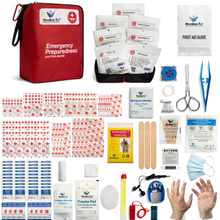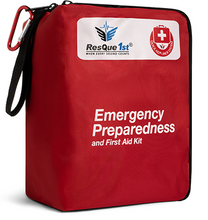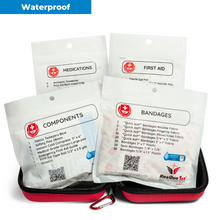
Summer vacation! I have fond memories of family trips up and down the East Coast of the United States. We would pack up the car and hit the road, singing songs and playing “Punch Buggy”, “I Spy” and the license plate game. But I also remember that my father had very specific safety rules (Bottoms on the seat, seat belts on and no hands out the windows) and always kept an emergency kit close by so that he could remove splinters, bandage cuts and even splint a sprained finger no matter where we were. So in the spirit of fun and family, here are some tips you can use to safely travel by car, whether it be to the grocery store or on long weekend drives to the country.
Preparing the Car
- When planning a trip, be sure to schedule in extra time for traffic or rest stops to get food, use the bathroom or make phone calls.
- Keep your car in good working order. Have a mechanic check the following basics: fluids (washer fluids, antifreeze, oil, etc.), battery and ignition system, brakes, exhaust system, fuel and air filters, heater and defroster, lights, thermostat. This is especially important before a trip to avoid any unpleasant surprises.
- Keep your gas tank full at all times. Fill it up before a long trip.
- If you are driving in snowy or icy conditions, install good winter tires.
- Ensure that there are no loose hard objects that could turn into projectiles during a sudden stop.
While Driving
- Keep your attention on driving at all times.
- Be aware of the drivers around you and be prepared to avoid other motorists.
- Drive the speed limit.
- Keep a safe distance between you and the car in front of you. A general recommendation is 2 seconds - or 4 seconds in bad weather.
The Children
- Secure infants and small children in a child safety seat. These significantly reduce the risk of injury in the event of an accident. But to be effective, you must have the appropriate seat properly installed and used. See The Ultimate Car Seat Guide for guidelines and practical advice.
- Children must wear a seat belt. Instruct your child how to properly fasten the seat belt in your car. This includes not tucking the shoulder strap under the armpit. Never allow two children to share a seatbelt.
- Children under the age of 13 should sit in the back seat. This helps prevent injury in case the passenger-side airbag deploys. The airbag is engineered to inflate at about chest level on an adult. Young children are smaller and the airbag will hit them in the face.
- Teach your children to stay calm and relaxed in the back seat. Fighting or demanding the driver’s attention is distracting and could cause him to drive unsafely and have an accident. Work with them to come up with quiet activities or games. Ensure that they bring soft toys or books that won’t cause harm during a sudden stop.
Be Prepared For An Emergency
Accidents are unforeseen and could could happen any time you are on the road, either in the car or at your destination. Be prepared to handle injuries by having a well-stocked emergency kit in your car. Also keep the following items stored in your car: a working spare tire, jumper cables, flares or a reflective triangle, flashlight, windshield washer fluid and motor oil, bungee cord, road maps if you don’t have a GPS, car cell phone charger, emergency food and water and extra clothing and shoes. If you are in snowy conditions, also include winter supplies such as an ice scraper and antifreeze, as well as cat litter or sand to provide traction in icy conditions.
Being prepared gives you peace of mind so that you can enjoy the trip as well as the destination.
For more car safety tips, please visit these sites: Nationwide.com, Ready.gov, Kidshealth.org.









